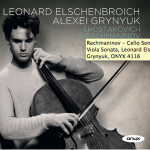 Rachmaninov and Shostakovich sonatas. Leonard Elschenbroich, cello & Alexei Grynyuk, piano. ONYX 4116. Distributed by Harmonia Mundi.
Rachmaninov and Shostakovich sonatas. Leonard Elschenbroich, cello & Alexei Grynyuk, piano. ONYX 4116. Distributed by Harmonia Mundi.
What an interesting contrast of works! Rachmaninov’s Cello Sonata in G minor of 1901, was written when the composer was 28 and had another 40 years to his career. This is paired with Shostakovich’s final work, completed in 1974, four weeks before the composer’s death at 69, due to a not-pretty combination of heart attacks, polio, and lung cancer. Scored as a Viola Sonata, Op.147, the composer, on his deathbed, authorized Daniil Shafran to transcribe it for a cello.
The Rachmaninov is on the whole, romantic, predominantly lyric, with some saucy bits. And being Rachmaninov, his writing for piano shares the limelight with the featured cello (The second movement, oddly, reminds me of the kind of perky Stephen Foster Rags that William Bolcomb likes to write).
The first movement opens slowly with a theme that evokes a full moon and empty arms. The tempo picks up from lento to allegro, a pattern that alternates throughout the movement. The interplay between cello and piano parts is intriguing. Grynuk’s keyboard speaks declaratively, as if what he says can be said. Elschenbroich’s cello limns the personal, enigmatic, inexplicable feelings, making eloquent what cannot be said. Between them, the players bring out the subtley shifting colours of the mid-range mood of the movement, melancholy but not too, cheerful but not overly. The mood of enjoying not quite getting what you want.
One is reminded by the finale that Rachmaninoff’s tunes have a popular feeling. But, though this last movement is a celebration, the voice of Elschenbroich’s cello somehow keeps it reserved, tinged with a sadness that holds it down like the tail of a kite. The concluding coda revisits the opening theme and restores the sense of romance.
The Shostakovich is a whole other thing. Despite that like Rachmaninov, Shostakovich was a pianist, this sonata is for the string instrument. It opens pulsing pizzicato, wryly dissonant, with a wry piano line braided in, suggesting a transcendent level of sophistication and emotional awareness. The subsequent melodic variations reveal a subtler ear than Rachmaninov’s. The cello’s discourse, over a regular paced piano, is dilate, halting and jittery, keening upward like a disembodied entity till it just peters out. If ever there was a musical representation of life leaving the body, this is it.
The second movement, a scherzo, has the cello doing a peasant dance to an ostinato piano beat, unrestrained despite a sardonic tinge and passing strange at the end. The finale is an adagio, introducing a sad theme on cello recalling Beethoven’s Moonlight Sonata, and the sense of Edgar Allen Poe’s ominous, corvid utterance, “Never More.”
Elschenbroich immerses himself in the darkness of the fragmented cadenza in which the cello dialogues with itself. There are strong overtones of “Es Muss Sein,” the motto bowing to the unacceptable that Beethoven attached to Op. 135, his final Quartet. Elschenbroich and Grynyuk agree on giving Shostakovich’s final movement the longest, most attenuated ending you have ever heard.
As a bonus, there is appended a very tasteful and grounding 6 1/2 minute performance of Rachmaninov’s Vocalise,Op.34/14, arranged by Leonard Rose.
